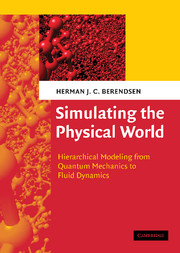Book contents
- Frontmatter
- Contents
- Preface
- Symbols, units and constants
- Part I A Modeling Hierarchy for Simulations
- 1 Introduction
- 2 Quantum mechanics: principles and relativistic effects
- 3 From quantum to classical mechanics: when and how
- 4 Quantum chemistry: solving the time-independent Schrödinger equation
- 5 Dynamics of mixed quantum/classical systems
- 6 Molecular dynamics
- 7 Free energy, entropy and potential of mean force
- 8 Stochastic dynamics: reducing degrees of freedom
- 9 Coarse graining from particles to fluid dynamics
- 10 Mesoscopic continuum dynamics
- 11 Dissipative particle dynamics
- Part II Physical and Theoretical Concepts
- References
- Index
11 - Dissipative particle dynamics
Published online by Cambridge University Press: 05 June 2012
- Frontmatter
- Contents
- Preface
- Symbols, units and constants
- Part I A Modeling Hierarchy for Simulations
- 1 Introduction
- 2 Quantum mechanics: principles and relativistic effects
- 3 From quantum to classical mechanics: when and how
- 4 Quantum chemistry: solving the time-independent Schrödinger equation
- 5 Dynamics of mixed quantum/classical systems
- 6 Molecular dynamics
- 7 Free energy, entropy and potential of mean force
- 8 Stochastic dynamics: reducing degrees of freedom
- 9 Coarse graining from particles to fluid dynamics
- 10 Mesoscopic continuum dynamics
- 11 Dissipative particle dynamics
- Part II Physical and Theoretical Concepts
- References
- Index
Summary
In this chapter we consider how continuum dynamics, described by continuum equations that are themselves generalizations of systems of particles, can be described by particles again. The particle description in this case is not meant to be more precise than the continuum description and to represent the system in more detail, but is meant to provide an easier and more physically appealing way to solve the continuum equations. There is the additional advantage that multicomponent systems can be modeled, and by varying the relative repulsion between different kinds of particles, phenomena like mixing and spinodal decomposition can be simulated as well. The particles represent lumps of fluid, rather than specified clusters of real molecules, and their size depends primarily on the detail of the boundary conditions in the fluid dynamics problem at hand. The size may vary from superatomic or nanometer size, e.g., for colloidal systems, to macroscopic size. Since usually many (millions of) particles are needed to fill the required volume with sufficient detail, is it for efficiency reasons necessary that the interactions are described in a simple way and act over short distances only to keep the number of interactions low. Yet, the interactions should be sufficiently versatile to allow independent parametrization of the main properties of the fluid as density, compressibility and viscosity.
- Type
- Chapter
- Information
- Simulating the Physical WorldHierarchical Modeling from Quantum Mechanics to Fluid Dynamics, pp. 305 - 312Publisher: Cambridge University PressPrint publication year: 2007

